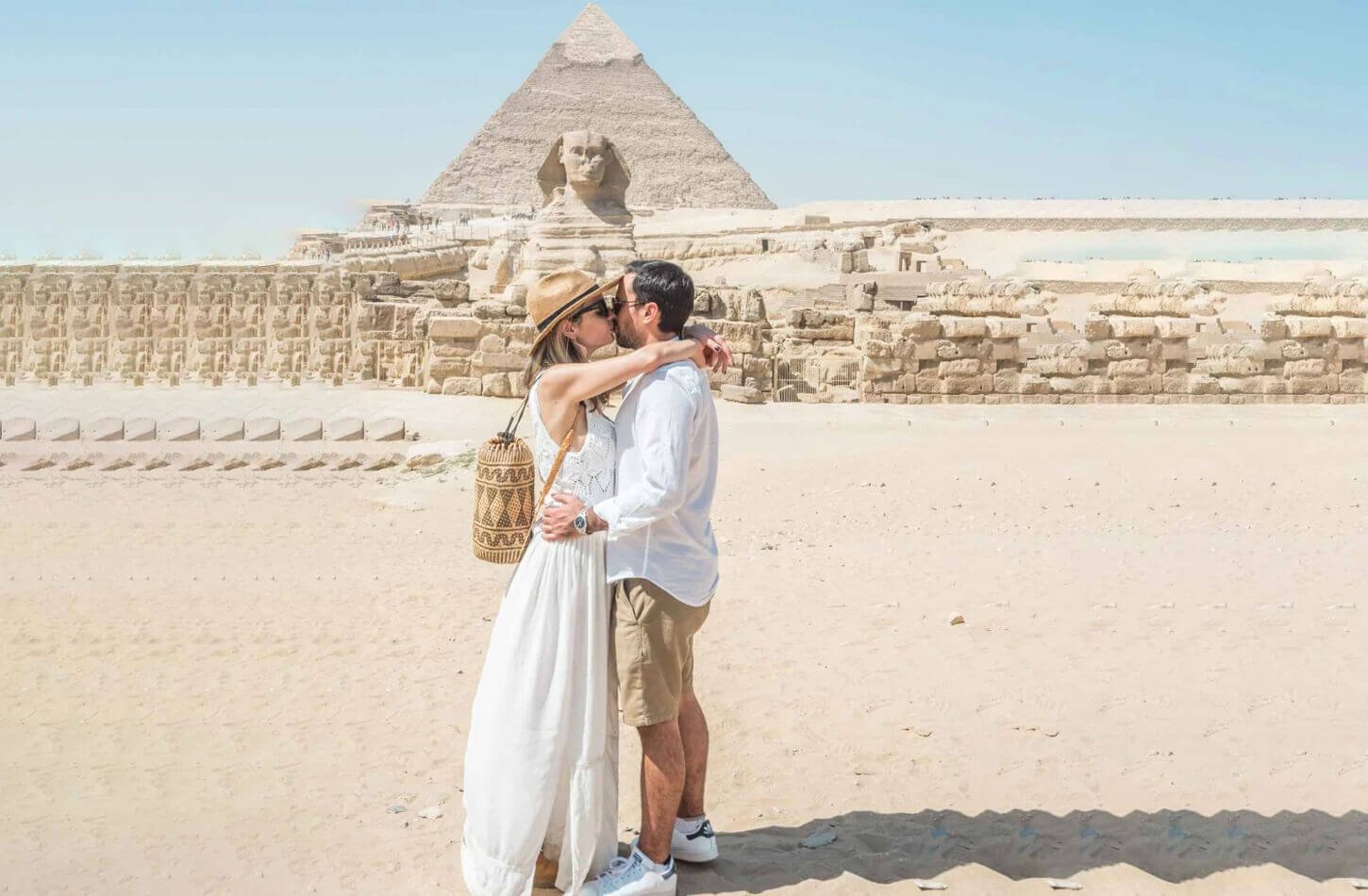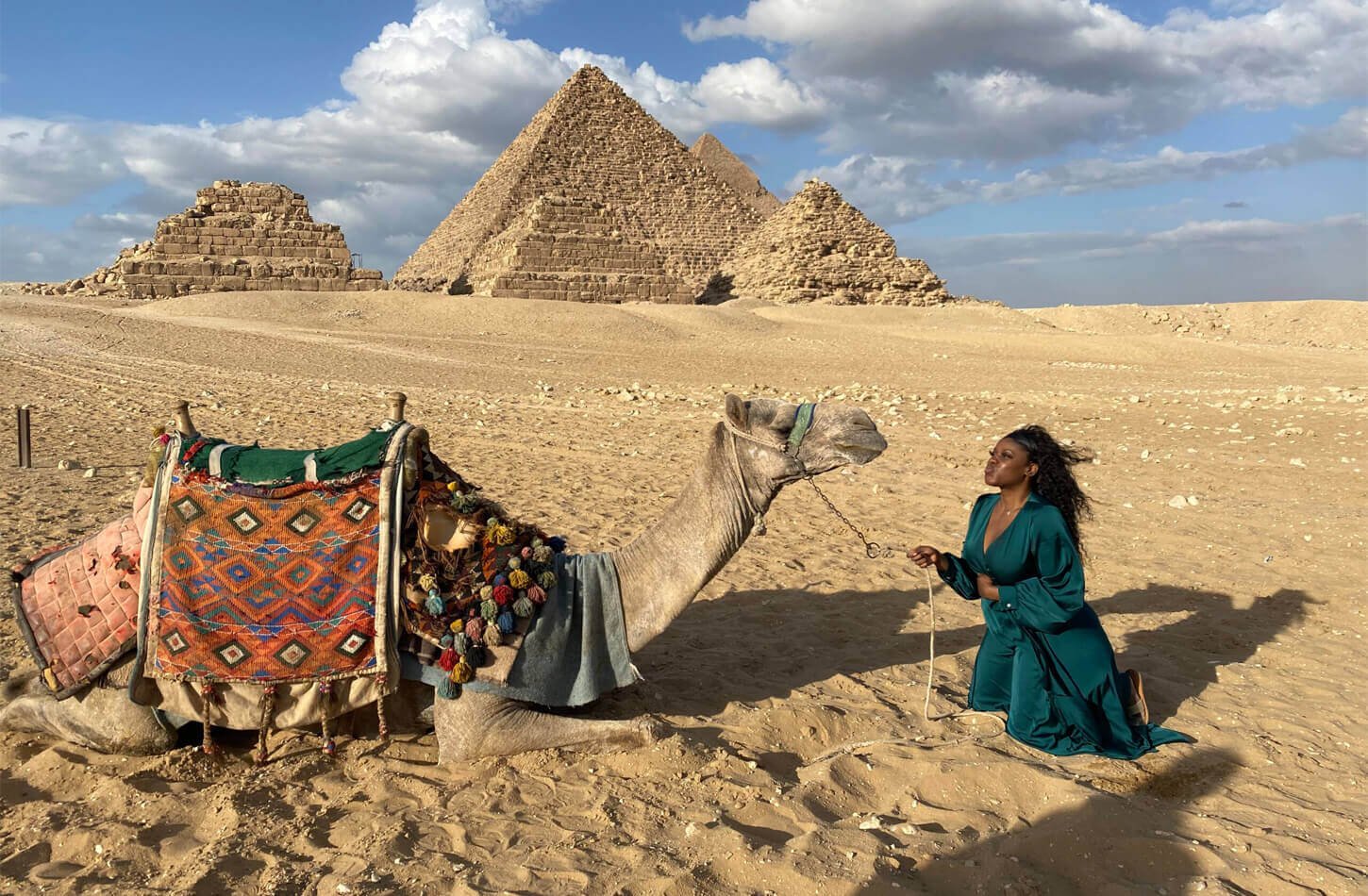Exploring the Great Pyramids is a journey into ancient history. The largest pyramid, built for Pharaoh Khufu, shows the skill of ancient Egyptians. It’s a marvel of Egyptian architecture.
The Pyramids of Giza are the only Ancient Wonders left standing. Visiting them gives you a peek into the past. Knowing their history makes your trip even more special.
The Magnificent Great Pyramids of Giza: An Overview
When you enter the Giza Plateau, you’re hit with the pyramid complex‘s grandeur. This place has been used for ages. It houses three main pyramids: the Great Pyramid of Khufu, the Pyramid of Khafre, and the Pyramid of Menkaure. Each pyramid has its own story and design that will amaze you.
The Great Pyramid of Khufu is truly impressive. Its huge size and perfect build show the ancient Egyptians’ skill. Walking around, you’ll see the fine details and massive size of these pyramids. They have lasted for centuries.
The Pyramid of Khafre and the Pyramid of Menkaure are also special. They show the pyramid complex‘s engineering and history. Visiting here is like traveling back in time. You learn about ancient Egypt’s culture and achievements.
The Giza pyramid complex is more than old buildings. It’s a trip back in time. As you wander, you’re surrounded by history. The pyramids stand as guardians of the past.
Planning Your Visit to the Pyramids: Essential Information
Seeing the Great Pyramids of Giza is a special experience. It needs some planning. The best time to visit the pyramids is early morning or late afternoon. This helps you avoid the strong sun.
Tips for a Smooth Visit
Knowing the Giza complex layout is key. Learn the map and plan your path ahead. Also, follow the rules to protect this ancient site.
For a Giza pyramids tour, pick cooler months. This way, you can explore without the heat. Wear comfy clothes, use sunscreen, and carry lots of water.
Visiting the Pyramids is a big part of Egypt tourism. Being ready will make your visit better. You’ll enjoy the history and beauty of the Pyramids more.

The Giza Pyramid Complex is home to some of the world’s most iconic structures. It’s easier to explore than you might think. The complex has clear paths to the main pyramids, making it simple to get around.
When you enter, you’ll see a layout that guides you to the main sights. Knowing where the Pyramids of Khufu, Khafre, and Menkaure are, plus the Great Sphinx, helps plan your day.
Start early to beat the crowds and heat. The Giza Plateau gets busy, so an early start is best. It makes your visit more peaceful.
Also, wear comfy shoes and drink lots of water. You’ll be walking a lot. With some planning, you’ll enjoy the pyramid complex without stress.
Step-by-Step Guide to Exploring the Great Pyramid of Khufu
The Great Pyramid of Khufu stands tall at 481 feet. It’s the largest pyramid and a top spot to visit at Giza.
When you get close, its massive size and engineering marvel will amaze you. The pyramid took over 20 years to build. This shows the ancient Egyptians’ hard work and skill.
Inside the Great Pyramid
Inside, you’ll see many interesting places. The Grand Gallery leads to the pyramid’s heart. There, you’ll find the King’s Chamber and the Queen’s Chamber.
These chambers show the pyramid’s detailed construction and history. The Great Pyramid of Giza is more than just a monument. It’s a window into ancient Egypt’s culture and achievements.
For a better visit, get a guide who knows a lot about the pyramid. They can make your experience even more special and help you see the pyramid’s greatness.
Discovering the Pyramid of Khafre: The Second Largest
The Pyramid of Khafre is a marvel of ancient Egyptian engineering. It’s the second-largest pyramid in the Giza Complex. It’s smaller than the Great Pyramid but still very impressive.
Unique Architectural Features: The Pyramid of Khafre stands out with its unique design. It was 143 meters tall and still has some original smooth stones at the top. These stones show what it looked like when it was first built.
The pyramid’s complex, including its well-preserved temple, offers insights into Pharaoh Khafre’s reign. Exploring this pyramid helps you understand Egyptian history and the value of archaeological treasures in the Pyramids of Giza.
Visiting the Pyramid of Khafre lets you dive into ancient Egypt’s rich history and culture. It’s a key part of the Giza Complex. It’s a must-see for anyone interested in Egyptian history and archaeological treasures.
Exploring the Pyramid of Menkaure: The Smallest of the Three
The Pyramid of Menkaure is a historical landmark you must see. It’s the smallest of the three main pyramids at Giza. Yet, it holds a special place in the hearts of many.
Built by Pharaoh Menkaure, this pyramid shows the advanced egyptian architecture of the Old Kingdom. Even though it’s smaller than the other two pyramids, it’s full of history. It gives us a peek into the era.
When you visit the Pyramid of Menkaure, you’ll see its unique features. Some of its original smooth exterior is still there. The pyramid’s internal chamber and the complex around it also show ancient rituals and burial practices.
Seeing the Pyramid of Menkaure lets you touch history. You’ll learn about Menkaure‘s reign and the ancient Egyptians’ skill. It’s a chance to see egyptian architecture up close. And it makes you think about the historical landmark‘s importance.
The Enigmatic Great Sphinx: Guardian of the Pyramids
As you get close to the Giza Complex, the Great Sphinx greets you. Its mystery is waiting to be solved. This huge statue has a lion’s body and a human head. It’s a key symbol of Ancient Egypt, showing the power and wisdom of old times.
People think it was built during the Old Kingdom, when Pharaoh Khafre ruled. The Great Sphinx is a wonder of ancient engineering. As a UNESCO World Heritage Site, it draws millions every year. They come for its mystery and beauty.
Standing before the Sphinx, you feel a mix of curiosity and awe. This feeling has lasted for centuries. The Sphinx’s secrets and stories show the deep history of Ancient Egypt.
The Great Sphinx is more than a monument. It’s a protector of the pyramids, a symbol of endless interest in the Great Sphinx and its area. Exploring this wonder lets you see Egypt’s ancient glory up close.
Beyond the Main Attractions: Hidden Gems of the Giza Complex
The Giza plateau is full of hidden treasures that show us more about Egyptian history. When you go past the big pyramids, you find many archaeological wonders. These are often missed by visitors.
The Tombs of the Nobles are a secret spot. Here, the nobles of ancient Egypt were laid to rest. These tombs give us a peek into the lives of the elite. You can see amazing wall paintings and reliefs in the tombs.
The Pyramid of Queen Khentkaus I is another hidden treasure. It’s near the Pyramid of Menkaure. This pyramid is special because of its history and unique design. Visitors can learn about the role of queens in ancient Egypt by exploring it.
The Giza Complex also has smaller pyramids and tombs. These are often ignored because of the big attractions. But they show us a lot about ancient Egypt’s funerary practices and social order. By visiting these places, you get a fuller picture of the Giza plateau’s history.
Exploring these hidden spots lets you see the deep history and culture of Egypt. This makes the Giza Complex truly fascinating.

Practical Tips for an Unforgettable Pyramids Experience
To make the most of your Giza pyramids tour, being prepared is key. The Great Pyramids of Giza are a famous spot. A bit of planning can make your visit memorable and fun.
First, dress modestly and be ready for the sun. The Egyptian sun is strong. Wear loose, light clothes, a hat, and sunscreen. Also, bring lots of water to stay hydrated.
Safety and Etiquette
It’s important to know and follow local customs and rules. Be aware of your surroundings and listen to guides and authorities. Also, respect any areas you’re not allowed in. This keeps you safe and helps protect the site.
Plan your visit when it’s cooler, like early morning or late afternoon. Having the right things, like comfy shoes and a camera, can also improve your experience.
By following these tips, your Egypt tourism trip will be unforgettable. Whether you’re looking at the ancient structures or exploring around, being ready lets you enjoy the Great Pyramids of Giza fully.
Understanding the Historical Significance of the Great Pyramids of Giza
Exploring the Great Pyramids of Giza is more fun when you know their history. These pyramids were tombs for the pharaohs of Ancient Egypt. They showed the pharaohs’ power and wealth. The Great Pyramid of Khufu is a marvel of architecture and shows the ancient Egyptians’ engineering skills.
The Great Pyramids of Giza are more than just amazing buildings. They give us a peek into ancient Egypt’s culture, beliefs, and ways of life. They show how important pharaohs were in Egyptian society and the religious beliefs behind these huge tombs.
Seeing the pyramids is a special chance to learn about egyptian history. As historical landmarks, they fascinate everyone. They offer clues about the people who built them and their society.
Learning about the Great Pyramids of Giza’s history makes them even more amazing. They are not just old buildings. They are proof of the ancient Egyptians’ creativity, skill, and beliefs.
Conclusion:
Visiting the Great Pyramids of Giza leaves a lasting impression. The pyramids show the skill and creativity of ancient times. They are a highlight of Egyptian architecture.
Your trip through Giza gives a special look at ancient wonders. You see the Pyramid of Khufu and the Great Sphinx. Each one tells a story of ancient Egypt’s history and culture.
Leaving the pyramids, you’ll remember your visit. It will make you appreciate ancient Egypt’s rich history more. The Great Pyramids of Giza are a must-see for anyone interested in ancient wonders.

